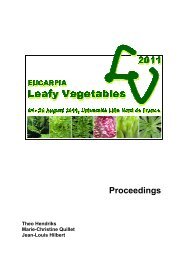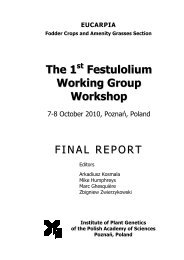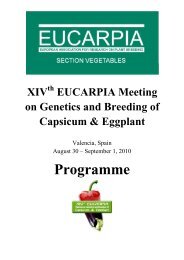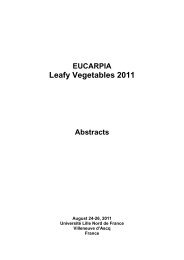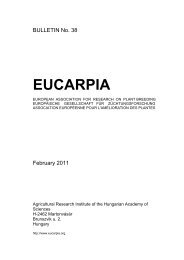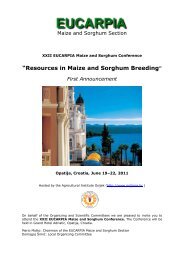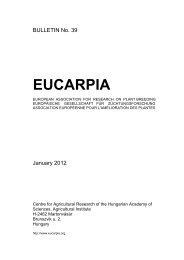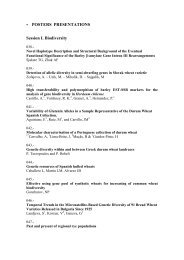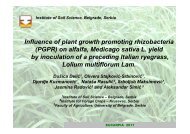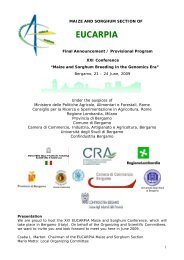Plant breeding for organic and sustainable, low-input agriculture
Plant breeding for organic and sustainable, low-input agriculture
Plant breeding for organic and sustainable, low-input agriculture
Create successful ePaper yourself
Turn your PDF publications into a flip-book with our unique Google optimized e-Paper software.
Maintenance <strong>breeding</strong> of conservation cereal varieties <strong>for</strong> <strong>organic</strong> farming in Denmark<br />
Anders Borgen, Per Grupe, Hans Larsson<br />
Agrologica, Mariager, Denmark<br />
The current area of <strong>organic</strong> farming is small compared with the cost <strong>for</strong> a conventional <strong>breeding</strong><br />
program, <strong>and</strong> the <strong>organic</strong> plant production suffers from a lack of diversity in the varieties offered<br />
on the <strong>organic</strong> seed market. Moreover, <strong>organic</strong> farming is more diverse than conventional<br />
<strong>agriculture</strong> in terms of growing conditions. There<strong>for</strong>e, <strong>organic</strong> farming has a high need <strong>for</strong> a<br />
wider range of varieties suited <strong>for</strong> different niches.<br />
Conservation or heritage varieties, <strong>and</strong> especially l<strong>and</strong>races often has a high level of genetic<br />
diversity within the varieties <strong>and</strong> may there<strong>for</strong>e satisfy the lack of diversity in varieties offered<br />
on the <strong>organic</strong> seed market. Heritage varieties also often have a high genetic variability within<br />
the varieties, which al<strong>low</strong>s <strong>for</strong> a relatively cheap maintenance <strong>breeding</strong> based on positive<br />
selection.<br />
Organic products are often sold at a surplus price on a market <strong>for</strong> quality products. In such a<br />
market, it is becoming increasingly important not only to provide a product <strong>and</strong> in<strong>for</strong>mation<br />
about the physical content, but also to offer in<strong>for</strong>mation about the background of the product,<br />
e.g. how <strong>and</strong> where it was produced, <strong>and</strong> by who. For the <strong>organic</strong> market, heritage varieties<br />
offers a unique storytelling about the product, were the history of the varieties, <strong>and</strong> the ef<strong>for</strong>t to<br />
conserve plant genetic resources adds value to produce in line with modern marketing principles.<br />
There<strong>for</strong>e, the heritage varieties need a thorough evaluation <strong>for</strong> growth habit in <strong>organic</strong> farming<br />
<strong>and</strong> <strong>for</strong> quality traits including backing <strong>and</strong> malting quality.<br />
Varieties of Danish origin <strong>and</strong> other varieties grown in Denmark be<strong>for</strong>e 1950 are requested from<br />
genebanks <strong>and</strong> other sources. The history of the varieties are being described based on historic<br />
literature, <strong>and</strong> the varieties are grown in the field <strong>for</strong> assessment of agronomic per<strong>for</strong>mance <strong>and</strong><br />
quality traits. In the first year, only few seeds are available, <strong>and</strong> these are grown <strong>for</strong><br />
multiplication under <strong>organic</strong> conditions at The Swedish Agricultural University (SLU) in Alnarp.<br />
Homogeneous lines are in the second year grown in 15 m 2 plots under <strong>organic</strong> conditions in<br />
loamy soil at Mørdrupgård in Denmark. In the third year, the lines are grown in 15 m 2 plots in 4<br />
replications at Mørdrupgård in Denmark <strong>and</strong> under <strong>organic</strong> conditions in s<strong>and</strong>y soil at The<br />
Danish Agricultural Museum. Positive selection in the material is made at SLU, Alnarp, <strong>and</strong> the<br />
selected material is grown in head rows <strong>for</strong> development of lines suitable <strong>for</strong> <strong>organic</strong> conditions.<br />
In addition to the Danish heritage varieties, Swedish heritage varieties which have already been<br />
selected <strong>and</strong> multiplied at SLU in previous projects, are grown at Mørdrupgård <strong>and</strong> at The<br />
Danish Agricultural Museum.<br />
The requested material include 82 barley varieties, 194 wheat varieties including Triticum<br />
aestivum, T.spelta, T. monococcum, T.sinskajae, T.dicoccon, T.turgidum, T.durum, 84 oat<br />
varieties <strong>and</strong> 23 varieties of common rye (Secale cereale) <strong>and</strong> midsummer rye (S. cereale var.<br />
multicaule).<br />
The experiments shows that within the heritage genetic resources, varieties are identified with<br />
unique quality traits, including taste, colour <strong>and</strong> backing quality, which are not found in high<br />
yielding modern varieties available <strong>for</strong> <strong>organic</strong> farming. The poster presents the second year<br />
result of field evaluation of 212 Sc<strong>and</strong>inavian heritage varieties grown in two sites in Denmark<br />
in 2007.<br />
51




